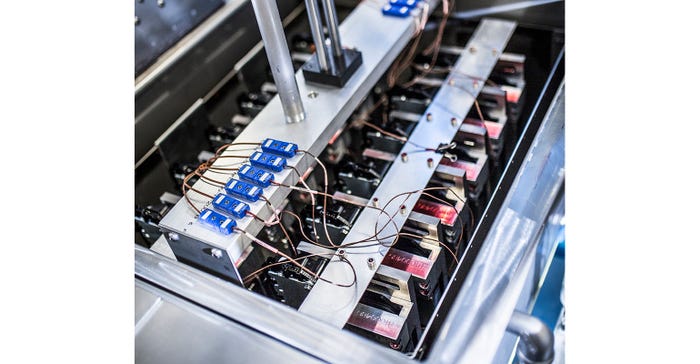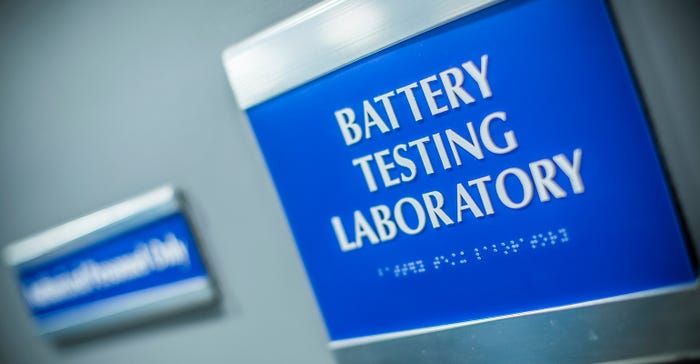Fail Fast, Learn Fast: The Role of Testing in Battery Innovation & Production
As cell chemistries change and energy densities increase, our methods of identifying the safety, performance, or failure of a cell need to adapt.
August 2, 2023

Emily Klein, Materials Engineer, Element Materials Technology
Batteries are playing an increasingly crucial role in the energy transition, advancing the reliability and span of renewable energy, and improving the consumer experience. Referring to an energy storage device—a cell or cells—and circuitry, the ability for cells to get lighter, last longer, and load more power is one of the chief advantages of batteries. The advancement of energy storage holds the key to many of our future power needs.
For technology manufacturers, new and old, using higher-capacity cells can give them a significant competitive edge. Cell manufacturers have always pushed the boundaries of cell chemistry to both increase energy density and find solutions to safety concerns. For example, the safety issues presented by the liquid electrolyte have generated a push towards using a solid electrolyte. After many years of research, we are seeing a shift in the market that is calling on solid-state, with the hope it will bring us safer cells with higher energy density.
Prioritizing safety
While safety is at the forefront of the battery community's concerns, we have only seen a spike in commercially produced solid-state cells within the last two to three years. This means that testing solid-state cells is relatively unexplored; ‘solid-state’ can encompass cells that do not have entirely solid electrolytes but have some solid components added to the liquid electrolyte. These new cells are now being challenged to showcase their performance and safety through testing.

It can be common practice in a cell’s product development to wait until standards or regulatory testing is required before a supplier tests their cells to learn how they behave during a failure. For other suppliers, the cell may fail without intention—sometimes spectacularly—leading to an analysis of what went wrong and why. Given the time and cost of R&D and the need to keep up with the pace of technological change, it makes sense that suppliers want to get their products out to the market as soon as possible. A cell failure is typically seen as a setback in the cell development process, but this is far from the truth. Sending a cell into failure, with intention or not, can offer incredible insight into the construction quality, side reactions, gas generation, temperature, and force during failure. All this information is crucial to understanding risks and developing design solutions to mitigate these risks. Ultimately, consumers with a battery-powered medical device or handheld electronic should be able to trust that their product has been made as safe as possible.
The next generation of batteries could contain sodium, lithium, silicon, and solid-state electrolytes, creating emerging technologies that are the future for both storage and power. As advancements in this space are being made quickly, it is vital that we understand how they will behave under a range of conditions; in the world of batteries, that’s what safety means—knowing what will happen at the point of failure. To this end, testing is one of the most valuable parts of the development lifecycle. To take a ‘fail fast’ approach means a manufacturer can build the understanding of failure into the development process and know how to mitigate failure and resulting behaviors—saving time and money and reducing the likelihood of catastrophic incidents in the long run.
Testing proactively and holistically
One of the benefits of working in a facility that performs the whole lifecycle of a product’s testing is getting to see and react when the unexpected happens. With new cell chemistries, the unexpected is becoming expected. In cases where Element has observed a failure occur during performance testing under normal conditions, we have had the opportunity to start providing information on a cell failure immediately. After any kind of cell failure—intended or not—photography, X-ray, CT scan, material analysis, failure analysis, design review, and consulting help expedite the learning process. However, as cell chemistries change and energy densities increase, our previous methods of identifying the safety, performance, or failure of a cell will have to adapt as well.

An increase in energy density can result in cells burning hotter than before and leaving less evidence to use during analysis, which can make previous techniques obsolete. It is important to call upon our past expertise to solve a problem, but make sure our lens isn’t so narrow we ignore new challenges and solutions. Along with performance testing, we can analyze the process of failure using techniques such as thermal runaway, nail penetration, crush, impact, projectile, pinch, vibration, and drop, to provide manufacturers with insights into how and in what conditions their cells will fail. Through failure testing including fire propagation, controlled explosions, and projectile tests created within a safe environment, it is vital we work with R&D teams within the lifecycle of product development to provide brand certainty.
The future of battery regulations
As cells continue to evolve and are being tested, we need to focus on having regulations keep pace, which is often easier said than done. Issues—such as with e-bikes—have been documented and the response to safety issues has seen an increase in demand for mandatory certification and safety testing. Typically, standards and regulations are reactionary, but as the technical community and consumers become more aware of the risks, it is promising that we are seeing a more proactive approach. Being ahead of failure and using it as a tool to learn will help bring safe products to market faster and accelerate innovation.
Battery manufacturers are also facing pressure from the ‘right to repair’ legislation, which although not developed with batteries in mind, has a huge impact as consumers seek replacement batteries for electronics rather than replacing the whole product. To standardize or not to standardize is an industry debate that is unlikely to be resolved soon, with several factors at the heart of the discussion. In such a competitive market that relies on R&D and product development heavily, battery power, strength, and recyclability are often market drivers, but safety will always be foremost. However, the key takeaway is that pressure for recyclability and product life extension is no longer a fringe demand—it is our reality. For batteries and product developers, this is about finding a way to either extend battery life or make it easier to replace. The risk, as always, is that once the user has the freedom to change electronics themselves, they are more exposed to counterfeits and the associated problems, such as using a core battery product that is not safe.
Looking to the future of battery testing
Safety test outcomes are changing as the next generation of batteries emerges. Element works with both start-ups and large-scale tech businesses and sees many of the latest designs and techniques coming through, constantly building on our understanding and informing our expertise. For instance, as each cell becomes more powerful, it has the ability to fail even more dramatically. Our longstanding failure analysis expertise works hand in hand with the fail-fast approach and allows us to build an even greater experience of the technology and its future. In our Atlanta laboratory, we are currently creating machine learning software that takes failure data to build programs that will flag cells with discrepancies before they come to market. The value of this holistic approach, of collecting so much data and insight in one place within a fast-growing market, is going to allow us to play a bigger role in the energy transition, product development, and future technology growth.
The rapid pace at which this industry is advancing presents its challenges, requiring us to continuously keep up. However, the sheer excitement and limitless possibilities that this technology provides serve as a constant inspiration for the industry to remain focused. Our unwavering dedication aims to truly make tomorrow safer than today.
Emily Klein is a materials engineer at Element Materials Technology. Element will be exhibiting at The Battery Show and Electric & Hybrid Vehicle Technology Expo North America, Sept. 12–14 in Novi, MI.

You May Also Like



